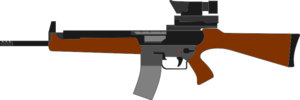TG-69
| Tjenestegevær 1969 | |
|---|---|
 TG-69O with IKO 3x Prismatic Optic | |
| Type | Assault rifle |
| Place of origin | |
| Service history | |
| In service | 1969-Present |
| Used by | |
| Production history | |
| Designer | Carsten Christoffersen Sidney Tranter |
| Designed | 1963-1967 |
| Manufacturer | Nationale Skydevåbenfabrikationssyndikat (NSFS) |
| Produced | 1969-Present |
| Specifications | |
| Weight | 2.91 kg |
| Length | 845 mm |
| Barrel length | 390 mm |
| Width | 67 mm |
| Cartridge | 5.56x45mm |
| Action | Short-stroke piston, rotating bolt |
| Feed system | 30-round detachable box magazine |
| Sights | Ghost ring iron sights |
The TG-69is a Gas-Operated Assault rifle chambered in 5.56x45mm. The TG-69 was designed by Chief Engineer Carsten Christoffersen and head Draftman Sidney Tranter, both working for NSFS. It competed in the Adaptiv Kampgevær program eventually being adopted by Lyngaard in 1969.
History
During the 1950's the Lyngaardian Royal Army was interested in replacing its now obselete Tjenestegevær 05, establishing the Adaptiv Kampgevær Program in late 1959. The Royal Ordinance and Procurment Department was looking for a weapon that took the best aspects of MP-57, particularly its ambidextarity. Nationale Skydevåbenfabrikationssyndikat (NSFS) would take part in the program, procuring several MP-57's for Chief Engineer Carsten Christoffersen and Head Draftman Sidney Tranter who headed a small team of engineers at the company. THe team would submit a prototype to the program.
The prototype would use multiple experiamental features, including a craft made composit carbon fiber - aluminium - steel barrel. During testing the Barrel would suffer a catastrophic failure. testers concluded that the failure was caused by improper melding of the composit materials. the Team woould go back and replace it with a new pencil barrel design being tested by NSNF. During testing it preformed well and was swiftly accepted after trials were complete.
the rifle would go through a few more iterations after adoption and would finally be designated the Tjenestegevær 1969. The rifle would go on to serve with the Royal Lyngaardian Army since. Servince in numerous conflict zones as part of peacekeeping forces. most notibly Operation Håb og Ret during the Third Asemese Civil War. There it would see combat, becoming appreciated by its soldiers for its light weight, handiness, and resistence in ingress and debris. captured and smuggled examples would also become favorites amongst Mai-Mai rebel forces during the conflict.
Whilst the Army has signaled its intent to replace the aging platform, said procurment has been pushed back to as late as 2034 extending the service life of the rifle for the forseeable future.
Design
the TG-96 is a select fire assault rifle using a short stroke gas piston system and a rotating bolt locking mechanism with 8 locking lugs. The rear part of the cocking handle slot on, cut on both sides of the rifle the upper receiver for the cocking handle, is covered by a spring-loaded cover which automatically opens by the handle when it goes back and automatically closes the opening when the cocking handle returns forward. The TG-69 also uses a spring-loaded dust cover similar to that used in the MP-57. when fired the force of the ejecting cases opens the dust cover, once the firearm stops firing the dust cover returns under spring tension. the upper reciever is made of stamped steel, while the lower is milled from aluminium billet. The Grip and Buttstock are a single piece of wood infused bakelite, in the T series of rifle the pistol grip is a stand alone piece. the magazine release is located behind the trigger and is flaired on both sides. it uses a simple lead spring design to retain tension on the magazine via a JSEC compliant notch magazine system. The TG-69 has a three postion adjustible gas port. one for normal operation, one adverse conditions, and a cut off. the pencil barrel is hardened and chrome lined. the rear sights are a simple ghost right apiture, with a standard 75m battle signt and is adjustible out to 500m. The front sight post is adjustible for windage and the rearsight is elevation adjustible.
Variants
- TG-69/T: Introduced in the late 70's and early 80's the T variant is given to rifles fitted with a new grip and telescoping but stock. used by Airborne and Mechanized brigades, it eventually subplanted the standard rifle in the early 2000's.
- TG-69/O: Has cuts made to attack optic mounts, was introduced along side the adoption of the IKO 3x Prismatic Optic in the late 80's
- TG-69/TO: TG-69/T fitted with an optic compatible TG-69/O upper reciver, subplanted the TG-69/T as the main service rifle in general infantry use around 2007.
- TG-69/KT: Carbine version with a shortant forend and gas system to accomidate a 266mm barrel, used the T series telescoping stock as standard.
- TG-69/KTO: TG-69/KT with the upper reciver of the TG-69/O. would subplant the TG-69/TO as by 2013 and remains the main service rifle of the army.
- TG-69/M: Modernized version, adding a Picatinny top rail, tri-rail forend. used by special forces since 2001 and has seen wider adoption in elite infantry formations.
- TG-69/M2: Revised version of the TG-69/M utilizing an M-lok style forend, used by special forces operating in Upper Asema since 2018, was evaluated for use amongst general infantry in 2021, however issues with maintaining long lasting zero on PEQ units caused it to fail evaluation. Current in service with the 3. Marinekommando Brigade, 3. luftbåren Battalion, and the 1. letfods Infanteriregiment.